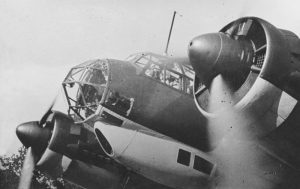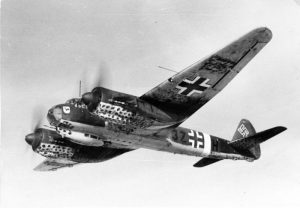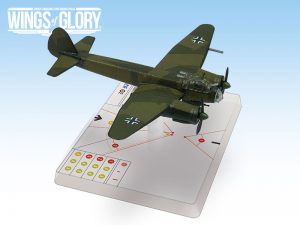Following the article about the Dornier Do.17, it’s time to learn more about the remarkable bomber named Junkers Ju.88, coming in WW2 Wings of Glory Squadron Packs in two versions: an A-1 model used by Kampfgeschwader 77 and an A-4 model from Küstenfliegergruppe 506.
The Junkers Ju.88 was another example of an interwar design concept for a “fast bomber” which would be able to outrun fighters of the day. Despite this concept proved incorrect, the Ju.88 became one of the most versatile multi-role aircraft of the war, serving as a medium bomber, torpedo bomber, deadly dive-bomber, recon plane, heavy fighter, and night fighter. At the end of the war, it even served as a flying bomb. Steadily manufactured from 1936 to 1945, with dozens of variants, it was the most produced dual-engine German plane of the war, with over 15,000 of all types constructed, in surprising roles as varied as bomber interceptor and even cannon-armed anti-armor versions!
The A-1 was the very first Ju.88 to enter mass production, but significant development problems slowed its entry into operational use. Only 12 planes saw action in Poland and not many more in Norway. At the time of the Battle of France, the Ju.88 was being integrated into “mixed” bomber squadrons which fielded a variety of types.
Nearly half of the losses of the Ju.88 In the Battle of Britain were due to accidents and malfunctions and its losses exceeded both the He.111 and Do.17 despite it being the least common bomber. Early planes were ‘tricky’ to fly—a price to be paid for them being more maneuverable than most planes of their size. Like the Do.17, grim experiences against the RAF saw the planes up-armored and up-gunned during the campaign.
Just taking the field in the closing days of the Battle of Britain, the A-4 corrected many of the problems the A-1 had and turned the Ju.88 into a durable, reliable plane, generally considered the “definitive” bomber version. With different engines, a slightly longer wing and better defensive armament, the A-4 was the plane the Germans would depend on for tactical excellence. Many bomb squadrons switched from the Do17 to the Ju.88 and performed multi-role functions on all Axis fronts.
Junkers Ju.88 in Wings of Glory
Within WW2 Wings of Glory, the Ju.88s can be key elements in your scenarios as it is able to dive bomb precision targets (like bridges or ships) while being faster, sturdier, and more maneuverable than the Stuka, but still in need of protection from enemy fighters. This will give you difficult decisions like should you keep the Me.110 with them for “close protection” or try to make offensive strikes with your Me.109s to keep the RAF from even getting close to the bombers? You decide!
The Junkers Ju.88 A-1 model comes with markings for three different planes in KG 77, one of the original German bomber wings, which was air ready when the war began and participated in most of the campaigns through 1944. It participated in the Battle of Britain and made particular efforts in anti-shipping roles, with one squadron being assigned to assist the battleship Bismarck when it got within range. Against the Soviets, it worked with Army Group North and was very effective in anti-shipping operations as well as tactical support. It was later transferred to the western front, fighting in North Africa, Italy, and back to France in anti-shipping roles. The unit was trained in all forms of bombing and torpedo attacks.
Skills include the chance to replace a wounded pilot with a gunner, improved bombing ability, better fire suppression, additional armor, and a MG for the pilot.
The Junkers Ju.88 A-4 model comes with decals for three different planes from Küstenfliegergruppe 506, a coastal recon and naval support unit, which used a variety of planes from the opening days of the war and began receiving the Ju.88 A-4 in April 1941. It then saw service on the northern sector of the Russian front – based both in the Baltic States and in Finland.
Skills include precision bombing, dangerous defensive fire, an extra MG, and extra armor and crew protection.
Information sources: "Warplanes of the Luftwaffe", Donald, David (London, Aerospace Publishing, 1994), "Bombers of the Luftwaffe", Dressel, Joachim and Manfred Griehl (London, Arms and Armour/DAG Publications, 1994), "Ju 88 Kampfgeschwader on the Western Front", Weal, John (Osprey Publishing, 2000), "Junkers Ju 88 Aircraft of World War II", Winchester, Jim (London, Grange Books, 2004), "Junkers Ju 88 Kampfgeschwader on the Russian Front", Weal, John (Bloomsbury Publishing, 2006), Feldgrau.com - WW2 German Küstenfliegergruppen.
Image attribution: *Bundesarchiv, Bild 101I-417-1766-03A / Ellerbrock / CC-BY-SA 3.0 / CC BY-SA 3.0 DE.













Follow Us on